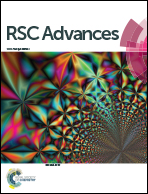Cardiac screening of intact Drosophila melanogaster larvae under exposure to aqueous and gaseous toxins in a microfluidic device†
Abstract
Drosophila melanogaster is one of the promising model organisms for investigation of human diseases such as cardiac disorders. However, intact (not dissected) Drosophila larvae have not been extensively used as models in cardiac toxicity assays due to many challenges associated with assessment of their heart activities in the intact mode (i.e., heartrate monitoring of alive larva under exposure to aqueous and gaseous reagents). These challenges include the need for precise spatiotemporal control of stimulus exposure to posterior spiracles (i.e., breathing valves) and full immobilization of larvae in favorable orientations to monitor the heart under a microscope. In this paper, we not only present a novel microfluidic device that is capable of loading, orientating and immobilizing the larva reversibly in a chip, but also demonstrate for the first time the transient effects of toxic liquids (e.g., sodium azide) and gases (e.g., oxygen and carbon dioxide) at various concentrations on the heart of intact Drosophila larvae. The results demonstrated that cardiac activity increase (with excess oxygen) or arrest (with sodium azide, carbon dioxide, or lack of oxygen) are highly dependent on the concentration of the stimuli, but heart recovery after removal of chemicals is independent of chemical concentration. The presented device can be used for investigation of biological pathways underlying these responses and also for screening of various chemicals such as pharmaceutical, toxicological, and agricultural compounds on the cardiac system of intact Drosophila melanogaster or other compatible insect models. This will open new windows of opportunity in drug discovery and toxicology applications.


 Please wait while we load your content...
Please wait while we load your content...